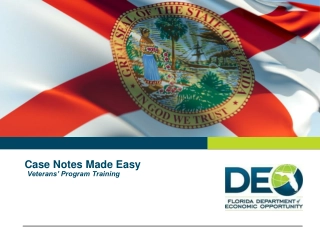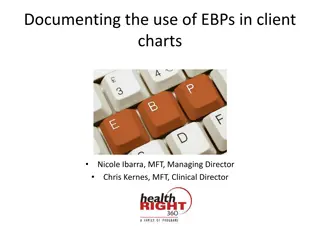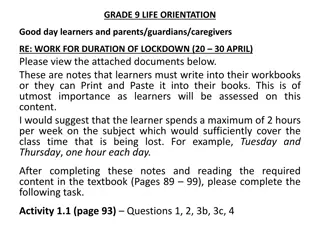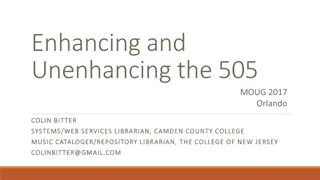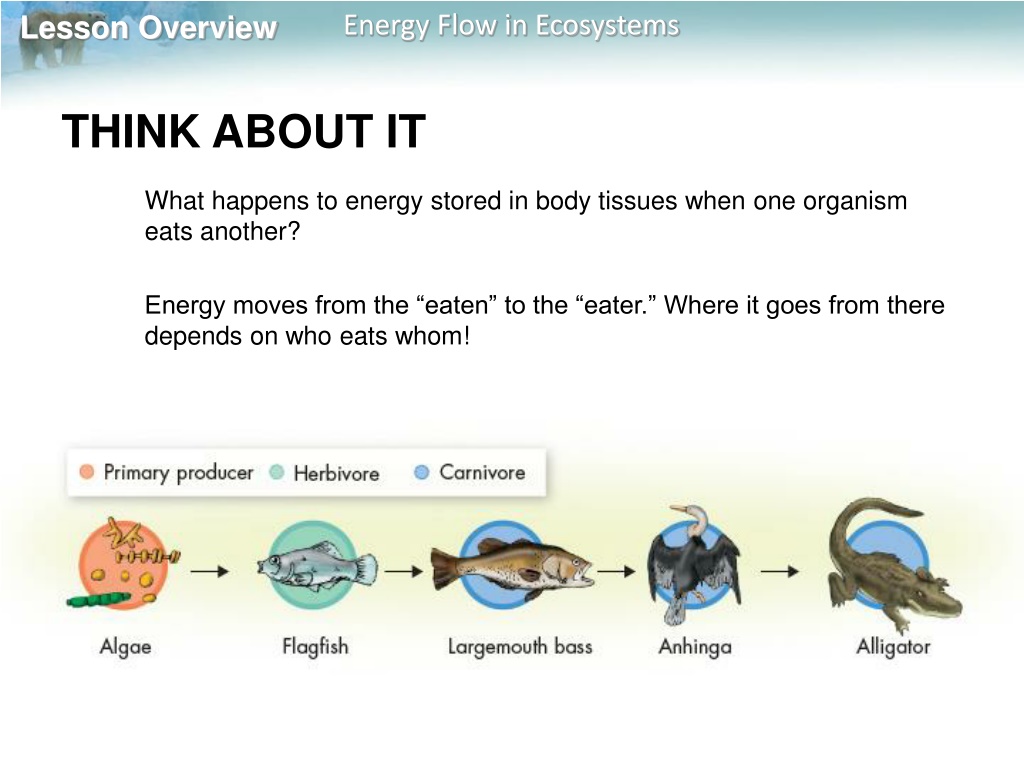
Understanding Energy Flow in Ecosystems
Explore the fascinating dynamics of energy transfer in ecosystems, from food chains to trophic levels and ecological pyramids. Learn how energy moves through different organisms and the vital role of decomposers in recycling nutrients. Discover the interconnectedness of species within a food web and the impact of disturbances on ecosystem balance.
Download Presentation

Please find below an Image/Link to download the presentation.
The content on the website is provided AS IS for your information and personal use only. It may not be sold, licensed, or shared on other websites without obtaining consent from the author. If you encounter any issues during the download, it is possible that the publisher has removed the file from their server.
You are allowed to download the files provided on this website for personal or commercial use, subject to the condition that they are used lawfully. All files are the property of their respective owners.
The content on the website is provided AS IS for your information and personal use only. It may not be sold, licensed, or shared on other websites without obtaining consent from the author.
E N D
Presentation Transcript
Lesson Overview Energy Flow in Ecosystems THINK ABOUT IT What happens to energy stored in body tissues when one organism eats another? Energy moves from the eaten to the eater. Where it goes from there depends on who eats whom!
Lesson Overview Energy Flow in Ecosystems Food Chains A food chain is a series of steps in which organisms transfer energy by eating and being eaten. Food chains can vary in length. An example from the Everglades is shown.
Lesson Overview Energy Flow in Ecosystems Food Chains Within Food Webs @Each path through a food web is a food chain.@ A food web, like the one shown, links all of the food chains in an ecosystem together. The orange highlighted food chain, presented earlier, is one of many that make up this web.
Lesson Overview Energy Flow in Ecosystems Decomposers and Detritivores in Food Webs Most producers die without being eaten. In the detritus pathway, decomposers convert that dead material to detritus, which is eaten by detritivores, such as crayfish, grass shrimp, and worms. Pig frogs, killifish, and other fishes eat the detritivores.
Lesson Overview Energy Flow in Ecosystems Decomposers and Detritivores in Food Webs At the same time, the decomposition process releases nutrients that can be used by primary producers. They break down dead and decaying matter into forms that can be reused by organisms, similar to the way a recycling center works. @Without decomposers, nutrients would remain locked in dead organisms.@
Lesson Overview Energy Flow in Ecosystems Food Webs and Disturbance In recent years, krill populations have dropped substantially. Given the structure of this food web, a drop in the krill population can cause drops in the populations of all other members of the food web shown.
Lesson Overview Energy Flow in Ecosystems Trophic Levels and Ecological Pyramids Each step in a food chain or food web is called a trophic level. @Primary producers always make up the first trophic level. @ Various consumers occupy every other level. Some examples are shown.
Lesson Overview Energy Flow in Ecosystems Pyramids of Energy Organisms expend much of the energy they acquire on life processes, such as respiration, movement, growth, and reproduction. Most of the remaining energy is released into the environment as heat a byproduct of these activities.
Lesson Overview Energy Flow in Ecosystems Pyramids of Energy @On average, about 10 percent of the energy available within one trophic level is transferred to the next trophic level.@ The more levels that exist between a producer and a consumer, the smaller the percentage of the original energy from producers that is available to that consumer.
Lesson Overview Energy Flow in Ecosystems Pyramids of Biomass and Numbers The total amount of living tissue within a given trophic level is called its biomass. The amount of biomass a given trophic level can support is determined, in part, by the amount of energy available.
Lesson Overview Energy Flow in Ecosystems Pyramids of Biomass and Numbers A pyramid of biomass illustrates the relative amount of living organic matter at each trophic level. @Typically, the greatest biomass is at the base of the pyramid, as is seen in the field ecosystem modeled here.@
Lesson Overview Energy Flow in Ecosystems THINK ABOUT IT A handful of elements combine to form the building blocks of all known organisms. Organisms cannot manufacture these elements and do not use them up, so where do essential elements come from? How does their availability affect ecosystems?
Lesson Overview Energy Flow in Ecosystems Recycling in the Biosphere Unlike the one-way flow of energy, matter is recycled within and between ecosystems. Elements pass from one organism to another and among parts of the biosphere through closed loops called biogeochemical cycles, which are powered by the flow of energy.
Lesson Overview Energy Flow in Ecosystems Biological Processes Biological processes consist of any and all activities performed by living organisms. These processes include eating, breathing, burning food, and eliminating waste products.
Lesson Overview Energy Flow in Ecosystems Geological Processes Geological processes include volcanic eruptions, the formation and breakdown of rock, and major movements of matter within and below the surface of the earth.
Lesson Overview Energy Flow in Ecosystems Chemical and Physical Processes Chemical and physical processes include the formation of clouds and precipitation, the flow of running water, and the action of lightning.
Lesson Overview Energy Flow in Ecosystems Human Activity Human activities that affect cycles of matter on a global scale include the mining and burning of fossil fuels, the clearing of land for building and farming, the burning of forests, and the manufacture and use of fertilizers.
Lesson Overview Energy Flow in Ecosystems The Water Cycle Water molecules typically enter the atmosphere as water vapor when they evaporate from the ocean or other bodies of water. Water can also enter the atmosphere by evaporating from the leaves of plants in the process of transpiration.
Lesson Overview Energy Flow in Ecosystems The Water Cycle If the air carrying it cools, water vapor condenses into tiny droplets that form clouds. When the droplets become large enough, they fall to Earth s surface as precipitation in the form of rain, snow, sleet, or hail.
Lesson Overview Energy Flow in Ecosystems Nutrient Cycles What is the importance of the main nutrient cycles? Every organism needs nutrients to build tissues and carry out life functions. Like water, nutrients pass through organisms and the environment through biogeochemical cycles. The three pathways, or cycles, that move carbon, nitrogen, and phosphorus through the biosphere are especially critical for life
Lesson Overview Energy Flow in Ecosystems Nutrient Cycles The chemical substances that an organism needs to sustain life are called nutrients. @Every organism needs nutrients to build tissues and carry out life functions. @ Nutrients pass through organisms and the environment through biogeochemical cycles.
Lesson Overview Energy Flow in Ecosystems The Carbon Cycle Carbon is a major component of all organic compounds, including carbohydrates, lipids, proteins, and nucleic acids.
Lesson Overview Energy Flow in Ecosystems The Carbon Cycle Plants take in carbon dioxide during photosynthesis and use the carbon to build carbohydrates. Carbohydrates then pass through food webs to consumers.
Lesson Overview Energy Flow in Ecosystems The Carbon Cycle Geologic forces can turn accumulated carbon into carbon-containing rocks or fossil fuels.
Lesson Overview Energy Flow in Ecosystems The Carbon Cycle @Carbon dioxide is released into the atmosphere by volcanic activity or by human activities.@ Such as the burning of fossil fuels and the clearing and burning of forests.
Lesson Overview Energy Flow in Ecosystems The Nitrogen Cycle @All organisms require nitrogen to make amino acids, which are used to build proteins and nucleic acids, which combine to form DNA and RNA.@ Nitrogen gas (N2) makes up 78 percent of Earth s atmosphere.
Lesson Overview Energy Flow in Ecosystems The Nitrogen Cycle Nitrogen-containing substances such as ammonia (NH3), nitrate ions (NO3), and nitrite ions (NO2) are found in soil, in the wastes produced by many organisms, and in dead and decaying organic matter.
Lesson Overview Energy Flow in Ecosystems The Nitrogen Cycle Although nitrogen gas is the most abundant form of nitrogen on Earth, only certain types of bacteria that live in the soil and on the roots of legumes can use this form directly. The bacteria convert nitrogen gas into ammonia, in a process known as nitrogen fixation.
Lesson Overview Energy Flow in Ecosystems The Nitrogen Cycle Consumers eat the producers and reuse nitrogen to make their own nitrogen-containing compounds. Decomposers release nitrogen from waste and dead organisms as ammonia, nitrates, and nitrites that producers may take up again.
Lesson Overview Energy Flow in Ecosystems The Nitrogen Cycle Other soil bacteria obtain energy by converting nitrates into nitrogen gas, which is released into the atmosphere in a process called denitrification.
Lesson Overview Energy Flow in Ecosystems The Phosphorus Cycle @Phosphorus forms a part of vital molecules such as DNA and RNA. @ Although phosphorus is of great biological importance, it is not abundant in the biosphere.
Lesson Overview Energy Flow in Ecosystems The Phosphorus Cycle Phosphorus in the form of inorganic phosphate remains mostly on land, in the form of phosphate rock and soil minerals, and in the ocean, as dissolved phosphate and phosphate sediments.
Lesson Overview Energy Flow in Ecosystems The Phosphorus Cycle As rocks and sediments wear down, phosphate is released. Some phosphate stays on land and cycles between organisms and soil.
Lesson Overview Energy Flow in Ecosystems The Phosphorus Cycle Plants bind phosphate into organic compounds when they absorb it from soil or water.
Lesson Overview Energy Flow in Ecosystems Nutrient Limitation How does nutrient availability relate to the primary productivity of an ecosystem? If ample sunlight and water are available, the primary productivity of an ecosystem may be limited by the availability of nutrients.
Lesson Overview Energy Flow in Ecosystems Nutrient Limitation Ecologists are often interested in an ecosystem s primary productivity the rate at which primary producers create organic material. @If an essential nutrient is in short supply, primary productivity will be limited. @ The nutrient whose supply limits productivity is called the limiting nutrient.
Lesson Overview Energy Flow in Ecosystems Nutrient Limitation in Soil The growth of crop plants is typically limited by one or more nutrients that must be taken up by plants through their roots. Most fertilizers contain large amounts of nitrogen, phosphorus, and potassium, which help plants grow better in poor soil. Carbon is not included in chemical fertilizers because plants acquire carbon dioxide from the atmosphere. Micronutrients such as calcium, magnesium, sulfur, iron, and manganese are necessary in relatively small amounts, and are sometimes included in specialty fertilizers.
Lesson Overview Energy Flow in Ecosystems Nutrient Limitation in Soil All nutrient cycles work together like the gears shown. If any nutrient is in short supply if any wheel sticks the whole system slows down or stops altogether.
Lesson Overview Energy Flow in Ecosystems Nutrient Limitation in Aquatic Ecosystems Sometimes an aquatic ecosystem receives a large input of a limiting nutrient for example, runoff from heavily fertilized fields.
Lesson Overview Energy Flow in Ecosystems Nutrient Limitation in Aquatic Ecosystems The result of this runoff can be an algal bloom a dramatic increase in the amount of algae and other primary producers due to the increase in nutrients. If there are not enough consumers to eat the algae, an algal bloom can cover the water s surface and disrupt the functioning of an ecosystem.
Lesson Overview Energy Flow in Ecosystems 1. Without these organisms, nutrients would remain locked in organisms A. Herbivores B. Producers C. Heterotrophs D. Decomposers
Lesson Overview Energy Flow in Ecosystems 2. How much energy is transferred from one trophic level to another? A. 100% B. 1% C. 10% D. 50% E. None of the above
Lesson Overview Energy Flow in Ecosystems 3. Which is not an ecological pyramid? A. Pyramid of biomass B. Pyramid of numbers C. Pyramid of Egypt D. Pyramid of energy
Lesson Overview Energy Flow in Ecosystems 4. The nutrient supply that limits productivity is known as A. Limiting nutrient B. Trophic level C. Denitrification D. Biomass
Lesson Overview Energy Flow in Ecosystems 5. What can affect the cycles of matter? A. Human Activity B. Geological processes C. Biological processes D. Chemical/Physical processes E. All of the above



